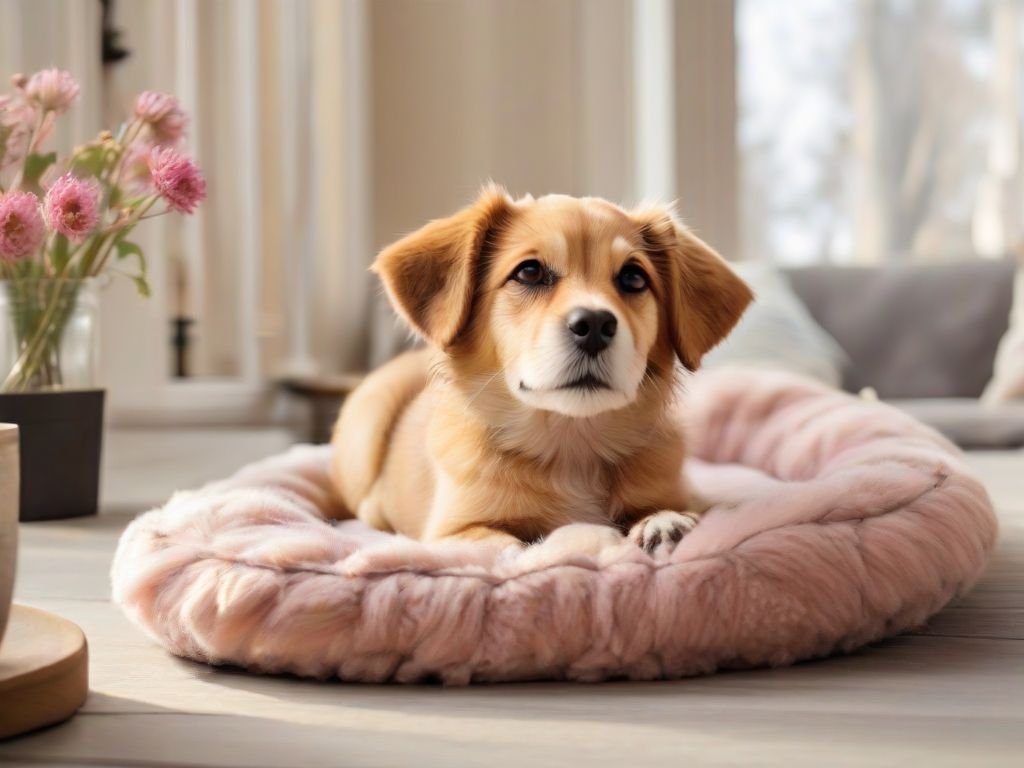When it comes to your furry friend, comfort is key. Most dogs do prefer soft beds because they provide a cosy place to rest and support their sleeping positions. Dogs often spend a whopping 15 hours a day napping, making a comfortable bed essential for their overall well-being.
Choosing the right bed can help your dog feel secure and relaxed. Soft beds tend to offer warmth and cushion, which is particularly helpful for dogs who enjoy curling up or sleeping on their side. You’ll want to consider your dog’s preferences and any specific needs they may have.
As you explore the world of dog beds, understanding what your dog likes is crucial. Providing them with a soft bed can greatly enhance their quality of life and ensure they are happy and healthy.
Understanding Canine Preferences
Every dog has their own likes and dislikes when it comes to resting places. Knowing how your dog shows comfort or discomfort will help you provide the best sleeping environment.
Signs of Comfort and Discomfort in Dogs
Your dog communicates their feelings through body language. Signs of comfort include curled-up positions or stretching out in their bed. These positions show they feel safe and relaxed. Listening to soft snoring can also indicate contentment.
On the other hand, signs of discomfort may include restless behaviour, frequent changing of positions, or whining. If your dog is pacing or seems anxious, their bed may not be suited for them. Look for indicators like panting or drooling, which can signal distress.
Understanding these signs will help you choose the right bed for your furry friend.
The Science Behind Canine Sleep Behaviour
Dogs are known to sleep a lot, often up to 14-15 hours a day. This behaviour helps them conserve energy and recover strength. A comfortable bed can significantly affect your dog’s sleep quality, impacting their mood and health.
Research shows that dogs prefer soft surfaces, especially as they age. Soft beds can provide joint support, reducing discomfort from arthritis or other mobility issues. Create a warm and inviting space that mimics a den-like environment, providing your dog with a sense of security.
By paying attention to your dog’s sleep behaviour, you can better understand what they need for a restful night’s sleep.
Benefits of Soft Beds for Dogs
Choosing a soft bed for your dog can greatly improve their comfort and well-being. These beds provide essential support, warmth, and a sense of security, which can enhance your dog’s overall quality of life.
Joint Support and Soft Surfaces
Soft beds are excellent for supporting your dog’s joints. They provide cushioning that can help relieve pressure on their bones and joints, which is especially important for older dogs or those with arthritis.
The right bed can reduce discomfort while sleeping, enabling your dog to rest better. These beds mould to your dog’s shape, offering support where it’s needed most. This can lead to a more enjoyable sleeping experience, helping your furry friend wake up feeling rejuvenated.
Warmth and Security
Soft beds often have materials that retain heat, making them warm and inviting. This is especially beneficial for dogs who may feel the cold more than others. A warm bed helps keep your dog cosy, promoting a better night’s sleep.
Additionally, the softness of the bed provides a sense of security. Dogs, like humans, find comfort in soft surfaces. A snug and plush environment can make them feel safe, which is essential if they get anxious during storms or fireworks.
Soft Beds and Anxiety Relief
For anxious dogs, a soft bed can be a real benefit. The cushioning of these beds can help your dog feel more secure, reducing feelings of stress. Many dogs enjoy digging or burrowing before settling down, and soft beds cater to this instinct.
Furthermore, soft beds can be paired with familiar blankets or toys, creating a safe zone that helps soothe your dog. This familiar territory can provide a calming effect, making it easier for your pet to relax and sleep peacefully.
Choosing the Right Bed for Your Dog
Finding the perfect bed for your dog involves considering several factors. You’ll want to think about your dog’s size and breed, the materials used in the bed, and how easy it is to keep clean. All these aspects help ensure your furry friend gets the comfort and support they need.
Size and Breed Considerations
When selecting a bed, size matters. Measure your dog from nose to tail and choose a bed that allows them to stretch comfortably. For larger breeds, such as Great Danes or St. Bernards, opt for extra-large beds.
Common Size Recommendations:
- Small Breeds: Chihuahuas, Dachshunds (S: approximately 45-60 cm long)
- Medium Breeds: Beagles, Bulldogs (M: approximately 60-80 cm long)
- Large Breeds: Labradors, Boxers (L or XL: approximately 80-100 cm long)
Check breed-specific preferences, as some dogs may favour softer or firmer beds. If your dog has any health issues, a supportive bed could be beneficial for their joints.
Materials and Durability
The materials of the dog bed can greatly affect its comfort and lifespan. Many dogs prefer soft bedding, but it should also offer support. Look for options like memory foam, which can adapt to your dog’s shape.
Materials to Consider:
- Cotton: Soft and breathable.
- Memory Foam: Provides excellent support.
- Orthopaedic Foam: Good for older dogs with joint pain.
Durability is essential, especially if your dog likes to chew or dig. Select beds with reinforced seams and durable fabrics to withstand their behaviour. Waterproof liners can also protect the bed from accidents.
Ease of Cleaning
Keeping your dog’s bed clean is crucial for their health. Choose beds with removable, washable covers for convenience. This feature will save you time and ensure your dog always has a fresh, clean space.
Cleaning Tips:
- Check Labels: Washable covers should be machine-safe.
- Regular Maintenance: Vacuum the bed weekly to remove hair and debris.
- Odour Control: Use dog-safe sprays to keep it smelling fresh.
A clean bed not only helps prevent allergies but also provides a comfortable spot for your dog to relax.
Training Your Dog to Use a Soft Bed
Getting your dog to use a soft bed can be a rewarding experience for both of you. With the right techniques, you can encourage your furry friend to love their new sleeping space.
Positive Reinforcement Techniques
Using positive reinforcement is one of the best ways to train your dog. Every time your dog approaches or lies on the soft bed, reward them with a treat or enthusiastic praise.
- Timing is Key: Make sure to give the reward immediately to create a strong connection.
- Consistency Helps: Use the same command or cue each time, like “bed,” to help your dog understand.
Repeat this process to reinforce the behaviour. Gradually, your dog will associate the soft bed with positive experiences. Be patient; it might take some time for them to feel completely comfortable.
Creating a Welcoming Bed Environment
Making the soft bed inviting is crucial. Try to place the bed in a quiet spot away from distractions. Adding familiar items can help too.
- Familiar Smells: Place a blanket or toy that has your scent on it. This can make the bed feel safer and more inviting.
- Comfort Matters: Ensure the bed is well-stuffed and easy to access. Avoid placing it in drafty areas.
Encourage your dog to explore the bed by tossing toys onto it or sitting next to it. Spend time near the bed with your dog, rewarding any positive interaction. This helps build a connection between your dog and their new sleeping area.
Special Considerations
When choosing a bed for your dog, there are a few important factors to keep in mind. Different dogs have unique needs based on their age, behaviour, and health. Understanding these factors can help you choose the perfect bed for your furry friend.
Older Dogs and Their Specific Needs
As dogs age, they may develop joint pain and stiffness. Soft beds can provide the support they need to feel comfortable. Consider getting an orthopaedic bed designed to alleviate pressure on their joints.
Look for beds with memory foam, as they can contour to your dog’s body shape. This helps distribute their weight evenly. Additionally, choose a bed that has a low profile for easier access. Older dogs may have trouble getting in and out of high beds.
Warmth and security are also vital for senior dogs. A bed that encloses them might make them feel safe. Keep in mind that older dogs also tend to sleep more, so a comfy bed will be crucial for their well-being.
Puppies and Bed Chewing Habits
Puppies are playful and often love to chew on things, including their beds. When selecting a bed for a puppy, look for durable materials that can withstand chewing. Some beds are specifically designed to be chew-resistant.
Consider choosing a bed with removable, machine-washable covers. This makes cleaning easier in case of accidents. It’s also wise to supervise your puppy during their chewing phase to prevent them from swallowing any material.
You may want to introduce the bed gradually. Encourage your puppy to use it by placing toys or treats inside. This will help them associate the bed with positive experiences and reduce the urge to chew on it.
Allergies and Hypoallergenic Bedding
Just like humans, dogs can suffer from allergies. If your dog shows signs of itching or irritation, it might be time to rethink their bedding. Hypoallergenic bedding is designed to minimise allergens, making it a good option for sensitive dogs.
Look for beds made from materials that resist dust mites and other allergens. Washable beds can also help keep allergens at bay. Regular cleaning reduces pollen and dirt that could irritate your dog’s skin.
Selecting the right bed can have a significant impact on your dog’s comfort and health. Pay attention to your dog’s reactions to their bedding and make adjustments as needed. Your dog’s well-being is worth the effort!
Product Reviews
Finding the right soft bed for your dog can make a big difference in their comfort and happiness. Here are some top-rated options and insights from customers to help you choose the best one.
Top-Rated Soft Dog Beds
- The Barney Bed
This bed is known for its plush comfort. Dogs love to snuggle into the soft materials, providing a cosy spot for rest. - Calming Dog Bed 2.0 by Fur King
Designed to reduce anxiety, this calming bed features raised edges for security. Many dogs enjoy burrowing into it, making it an excellent choice for anxious pets. - FurHaven Snuggery Burrow Dog Bed
This unique bed has a shapeable blanket for added warmth. Dogs who love to burrow often make it their favourite snoozing place. - Imperial Orthopedic Dog Bed
An affordable option, this bed provides great support while remaining soft. It’s perfect for older dogs who need extra cushioning.
In conclusion, while every dog has its own unique preferences, many dogs do seem to enjoy the comfort and security that a soft bed provides. A soft bed can support their joints, offer warmth, and provide a personal space where they feel safe and relaxed. However, it’s important to consider your individual dog’s needs, age, and health conditions when selecting the perfect bed. Observing your dog’s behavior and comfort level can be a helpful guide in choosing a bed that they truly enjoy. Ultimately, the best bed for your dog is one that meets their specific needs and contributes to their overall well-being and happiness.

